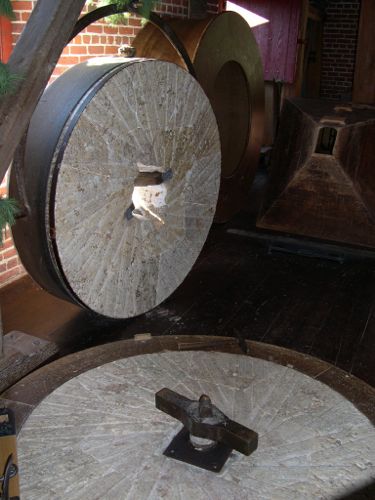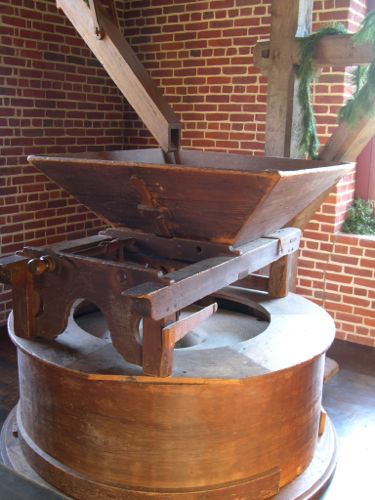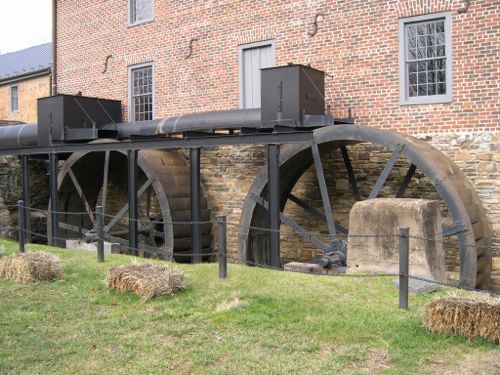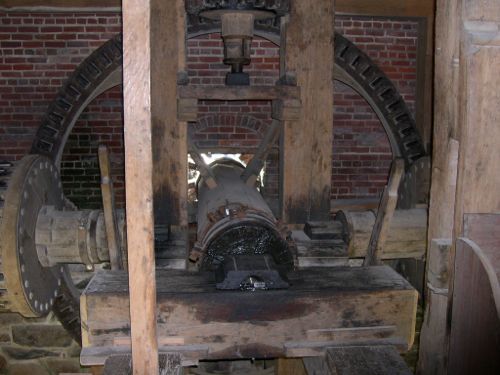Gristmill Under the Hood
Regular reader, good friend and world traveler Warren helpfully submitted these pictures over the weekend of Aldi Mill in Virginia. Still working (over the summers, anyway) it’s a classic example of the gristmills that could once be found all over the Midwest and Eastern US.
Here’s a terrific shot of the rocks…the runner above and the bed below with furrows cut into their faces. Based on the angles, you can how the stones cut the corn kernels with an almost scissor-like action.

When the mill is running the stones rotate in this wooden enclosure, which funnels the meal down below into a bin.

The Aldi Mill is a double-wheeler, which is unusual (but way cool). You can see the sluice above where the water flows over the wheels. It’s by controlling the rate of flow that the speed of the wheel (and the rotating stones) is increased or decreased. Most mills are of the pass-over type like this. There were pass-under water wheels as well, but I’m not sure of there are any of those still operating here in the States.

Here’s a shot of the gears, which gives you a glimpse of the manner in which the power was transferred. All-wood machines like this make a magnificent creaky, rumbly sound when they run.

Makes me way to close up shop and head for the nearest mill! Maybe they’re hiring. Thanks Warren!
“Most mills are of the pass-over type like this. There were pass-under water wheels as well, but I’m not sure of there are any of those still operating here in the States. ”
The historic Dexter’s grist mill in Sandwich, MA (Cape Cod) is an undershot mill.
http://capecodwindmills.scificincinnati.com/thomas_dexters_grist_mill.htm
Wonderful, Kelly! Thanks very much (now I have a new holiday destination).
Cheers,
– Joe
Definitely cool Joe, I love old style machines also!
Woodworking mills are one my favorite, and were
also powered by hydropower, at one time. In the
picture with the giant gear, I notice two power
take-offs. Does one water wheel turn more than
one mill?
I wondered that myself. Gristmills were put to a variety of uses: grinding wheat, grinding rye, grinding corn…each in varying grades (especially the corn which could be ground into flour or animal feed). Who knows what the local demands on this mill were? I’d be interested to go there and find out!
Hi Joe, in reply to Ben, Aldi Mill had 4 stones working, each pair driven by one of the wheels outside, plus the grain elevator and other machinery associated with the mill. The grain was unloaded into the bottom floor, then carried by elevator to the top floor, then gravity fed, supplied by people using shovels, from the top floor to the 3rd floor where the stones are. The ground meal dropped to the 2nd floor where it was weighed and bagged, then dropped to the ground floor for dispatch or held in the storage barn adjacent to the mill.
It is well worth the visit if you in that part of Virginia at any time.
Thanks again Warren!
– Joe
Dear Joe, Thanks for sharing these pictures of Virginia mills but I have to point out that 3 of the 4 pictures in this post are of Colvin Run Mill in Great Falls Virginia. We are still operating and are undergoing a major reconstruction to have our whole “Evans” system running by spring. Aldie is a very cool mill too but looks different on the inside. I am the Assistant Miller here at Colvin Run so feel free to contact me with any questions! Keep up the good posting!
Very interesting. Thanks, Stephen! My reader must have visited a couple of different mills and mixed up the pictures. Still very interesting!
Cheers,
– Joe